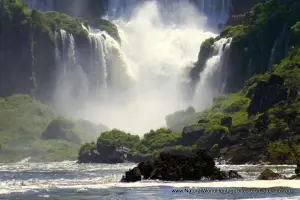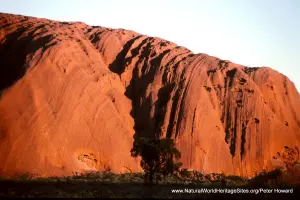EXPLORE Kakadu National Park with this slideshow, check the location map and get all the facts and information below.
For slideshow description see right or scroll down (mobile). Click to view slideshow
Location and Values: Kakadu is Australia’s largest national park, and one of the largest in the world’s tropics. Located in the far north of the Northern Territory it is primarily an area of fire-maintained tropical savanna woodlands, but it also preserves an astonishing diversity of other Australian ecosystems from tidal mudflats and mangroves in the coastal areas to vast expanses of freshwater wetlands and seasonally flooded forests, as well as sheer rocky cliffs and dry plateau lands. The area has been occupied by aboriginal peoples for 40,000 years and there is a wealth of cave paintings, rock carvings and archaeological sites that record the skills and lifestyle of these people over the millennia. From an ecological viewpoint, the coastal wetlands and floodplains in the north of the park are particularly dynamic environments, shaped by changing sea levels and extensive annual flooding, and providing seasonal habitat for millions of waterbirds. Kakadu supports an exceptional number of plant and animal species, with over a third of Australia’s bird species, and a quarter of the continent’s mammals recorded in the park.
Conservation Status and Threats. According to IUCN’s Conservation Outlook Assessment (2017) the conservation status of Kakadu National Park is of ‘significant concern’. The exceptional values which are recognized by the inscription of Kakadu National Park on the World Heritage List are threatened by:
- Mining. Uranium mining has been one of the main long-term threats to Kakadu National Park, with three enclaves leased out to mining companies. One of these (the Ranger uranium mine) is due to close in 2021 but in the meantime its ore has to be transported through the park with the risk of radioactive contamination, and the safe storage of uranium tailings is an ongoing concern. A second lease (at Koongara) was terminated in 2011, and the land has now been incorporated into the park.
- Invasive alien species. Alien plants and animals are displacing native species and affecting park habitats. There are many invasive weeds, including the floating fern Salvinia, various invasive grasses and species such as Mimosa pigra, Delonix regia, and Crotalaria goreensis. The most harmful invasive animals are buffalo, feral pigs, cats and cane toads, and these species are thought to have been (partially) responsible for a decline in northern quoll and reptile populations.
- Fire. Although fire is a natural element of the floodplain and woodland ecosystem in Kakadu National Park, there has been an increase in the extent and intensity of late season wildfires which has resulted (amongst other things) in a decline in small mammal populations. In response to this, new fire management practices have been introduced in recent years, mimicking the ancient practices of controlled burning by the native Binninj/Mungguy people.
- Climate change. The impacts of climate change are not yet fully understood but more frequent and intense rainfall events have occurred in recent years with increased flooding of the river systems in Kakadu National Park. Changes have been observed in the delicate balance between salt and freshwater wetlands through saltwater intrusion. In the longer term, it is expected that climate change will result in (1) sea level rise, (2) the risk of increased fire frequency and intensity due to drought, (3) increased frequency of weather events such as storms, and (4) increased populations of alien species, including pathogens.
Links:
Google Earth
UNESCO Official Website
IUCN Conservation Outlook
UNEP-WCMC Site Description
Birdlife IBA
Slideshow description
The slideshow ‘tells the story’ of Kakadu National Park, showing the landscapes, habitats, plants and animals. Most of the photos were taken by Peter Howard during a visit in December 1998, which included an over-flight of the northern part of the park. The aerial photos give a good general impression of the landscapes and diversity of habitats, including some of the cliffs, gorges and table-lands that characterize large parts of the park. Back at ground level, some of the typical wetland habitats are shown, with their lotus lilies, comb-crested jacana birds, crocodiles and terrapins. Rock overhangs and caves throughout the park have been used over the millennia as shelter by Aboriginal peoples, and some of their remarkable rock paintings are shown. This page of the website is still under development and a more detailed description of the various aspects of Kakadu National Park will be included in due course – so please come back again soon!
Factfile
Website Category: Tropical & Sub-tropical Savannas;
Area: 19,810 km2
Inscribed: 1981 (Extended 1987, 1992; modified 2011)
Criteria:
- Outstanding natural beauty (vii);
- Ecological processes (ix);
- Natural habitat for biodiversity (x);
- Cultural criteria (i,vi)





